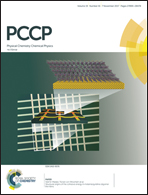Quantum effect enhanced magnetism of C-doped phosphorene nanoribbons: first-principles calculations
Abstract
Manipulating magnetism of low-dimensional materials is of great importance for their practical applications. Here, using first-principles calculations, we report a systematic investigation of the magnetic properties of C-doped H saturated zigzag phosphorene nanoribbons (H-ZPNRs), which are rather different from those of 2D periodic systems due to the quantum size effect. First of all, we observed a greatly enhanced magnetic moment locating mainly on the C atom and also slightly on its surrounding P atoms. Our results also indicated a strong dependence of the magnetic moment of the C atom on its location, which decays from the edge to the center site of the nanoribbons with an odd–even oscillating behavior originating from Friedel oscillation in low-dimensional materials. As for the C atom on a specific location, its magnetic moment decreases gradually with increasing width of H-ZPNRs, degenerating to the 2D case. What is more, we found that both the magnitude and the oscillating behavior of the magnetic moment on the C atom can be tuned by the edge saturation atoms. In addition, the case of two C atoms co-doping H-ZPNRs was also studied, showing non-magnetic (NM), ferromagnetic (FM) and antiferromagnetic (AFM) states depending on the locations of the two C atoms. Our findings suggest a plausible route for manipulating magnetism of the sp element doped H-ZPNRs, which are expected to have potential applications in spintronics.



 Please wait while we load your content...
Please wait while we load your content...